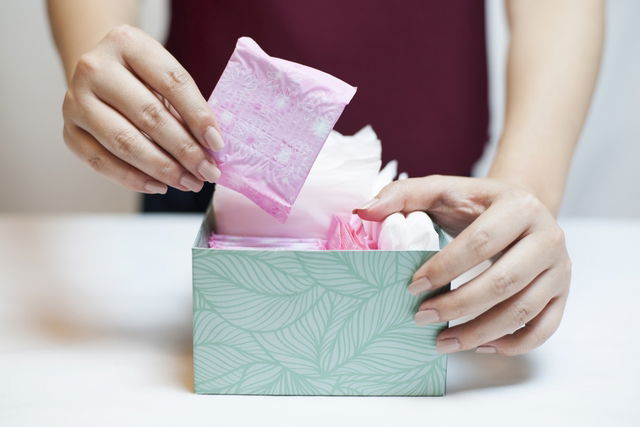Spotting refers to vaginal bleeding that occurs outside of your regular period. This type of bleeding is usually scant or low in quantity, occurs between periods, and lasts for about 2 days.
Spotting between periods is considered to be normal following vaginal exams, or after recent changes to birth control. Neither of these situations require treatment as they are not not a sign of any health issues.
Spotting between periods, however, may be a sign of pregnancy, especially if it occurs 2 to 3 days after unprotected sex. It may also be a sign of pre-menopause which occurs in women over the age of 40.

What am I spotting between periods?
The main causes of spotting between periods are:
1. Stress
Stress is one of the main causes of spotting between periods. During times or events that can make you feel overwhelmed, hormone levels can become imbalanced, leading to bleeding outside of a period.
What to do: Stress can be managed with simple techniques, like exercise, aromatherapy or engaging in pleasurable activities. However, moderate to severe stress that causes physical discomfort and spotting should be assessed by a psychologist, who can help to identify other approaches to coping with stress.
Also recommended: 7 Incredible Herbs for Anxiety, Insomnia & Stress tuasaude.com/en/herbs-for-anxiety2. Birth control changes
Changes to birth control can also lead to spotting between periods. It usually happens within the first days of the change, as the body works to regulate hormone levels.
Learn about the different birth control options that your doctor may consider for you.
What to do: if mild spotting occurs due to birth control changes, monitor the spotting for about a week, as this is about the time it takes for hormone levels to regulate. However, if spotting persists for longer or is very heavy, you should see your prescriber to assess whether the bleeding is related to the birth control and to start treatment as necessary.
3. Uterine polyps
Uterine polyps are more common in menopausal women, however they can also occur in younger women. They are associated with symptoms like difficulty getting pregnant, an irregular cycle, spotting between periods, spotting after sex, and lower abdominal pain that worsens during menstruation.
What to do: in most cases, uterine polyps do not require treatment, however your doctor may advise treatment if there is a risk of developing cancer.
4. Polycystic ovarian syndrome
Polycystic ovarian syndrome, or PCOS, is characterized by the presence of several cysts on one or both ovaries. They develop due to hormonal imbalances, which can lead to symptoms like spotting between periods.
Also recommended: 15 Ovarian Cyst Symptoms (with Online Symptoms Checker) tuasaude.com/en/ovarian-cyst-symptomsWhat to do: Treatment for PCOS should include lifestyle changes, including physical exercise, a balanced diet and weight loss. Very severe, persistent symptoms can be treated with oral contraceptives to regulate the menstrual cycle.
5. Thyroid problems
Thyroid abnormalities can also cause spotting between periods, as thyroid hormones can directly influence reproductive system functioning. They can impact hormones like estrogen and progesterone, causing symptoms like spotting between periods and difficulty getting pregnant.
Read about the symptoms of a thyroid problem and complete our online symptoms quiz to determine your risk for a thyroid condition.
What to do: you are advised to consult an endocrinologist to evaluate your thyroid function and assess the need to treat it. Check-out the thyroid tests your doctor may order to assess how your thyroid is working.
6. Vaginal infections
Vaginal infections caused by parasites, fungi or bacteria, including sexually transmitted infections, can cause spotting between periods. This bleeding can worsen if infections are left untreated.
What to do: depending on the type of infection, the doctor may prescribe medications to combat the responsible agent, such as antibiotics or antifungals.
7. After gynecological examinations
Some gynecological procedures, like a pap smear, can be invasive and cause scant amounts of bleeding or spotting. This is a completely normal finding and no treatment is necessary.
What to do: if the spotting lasts more than 2 days or if bleeding is moderate or severe in quantity, it is important to see a doctor for reassessment, as there may have been an injury caused during the gynecological examination.
Also recommended: Bleeding During Pregnancy: Causes (by Trimester) & What to Do tuasaude.com/en/bleeding-during-pregnancyWhen to see a doctor
You are advised to see a gynecologist if the spotting between periods:
- Is heavy
- Lasts for more than 3 days
- Occurs during more than 3 cycles
- Occurs after sex
Women who experience spotting after menopause should also be assessed. In these cases, the doctor may order tests, such as a pap smear, ultrasound or colposcopy to evaluate the woman's reproductive system and identify whether there is a problem causing the bleeding.
Also recommended: Brown Discharge: 11 Common Causes & When to Worry tuasaude.com/en/brown-vaginal-dischargeSpotting after sex
Spotting after sex is not a normally recurring finding. Some of the causes of vaginal bleeding after sex include:
- Sexually transmitted infections (STIs)
- Trauma during sex
- Presence of cervical wounds
- Lack of vaginal lubrication
- Cervical cancer
- Ovarian cysts
- Endometriosis
Spotting after sex should be assessed by a gynecologist, you may order testing to identify the underlying cause of vaginal bleeding.
